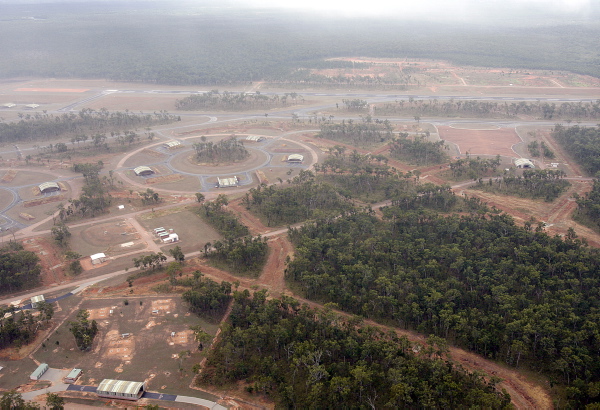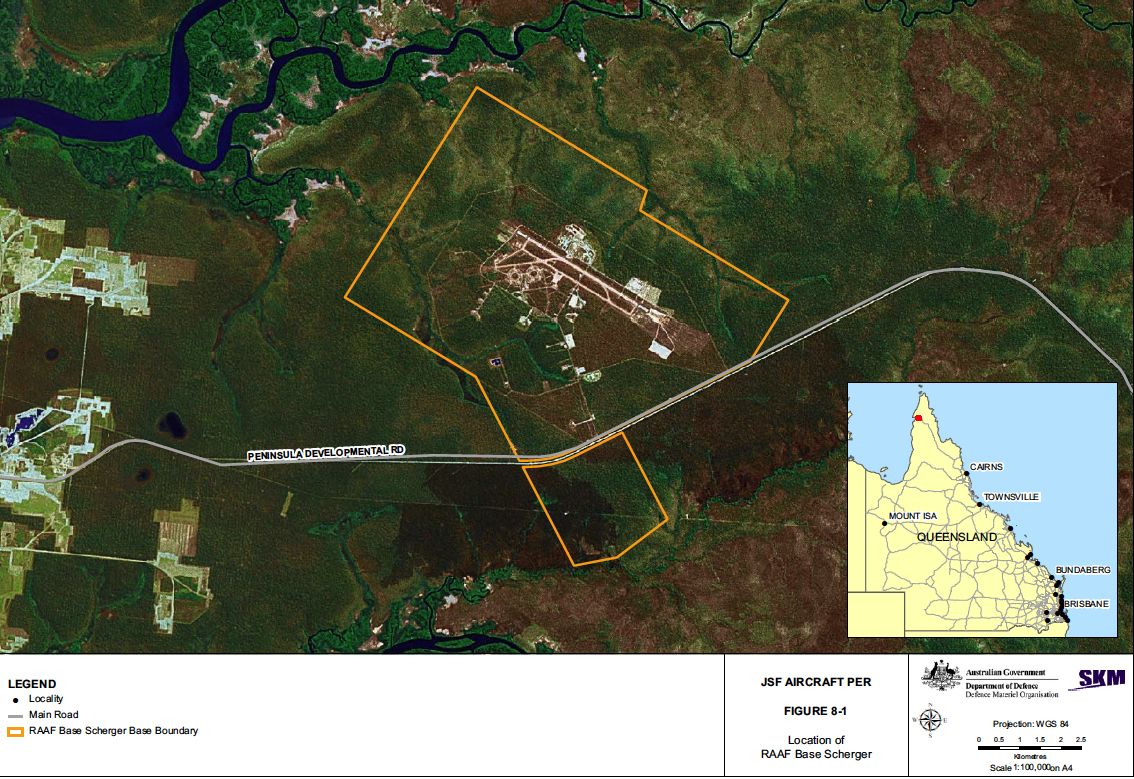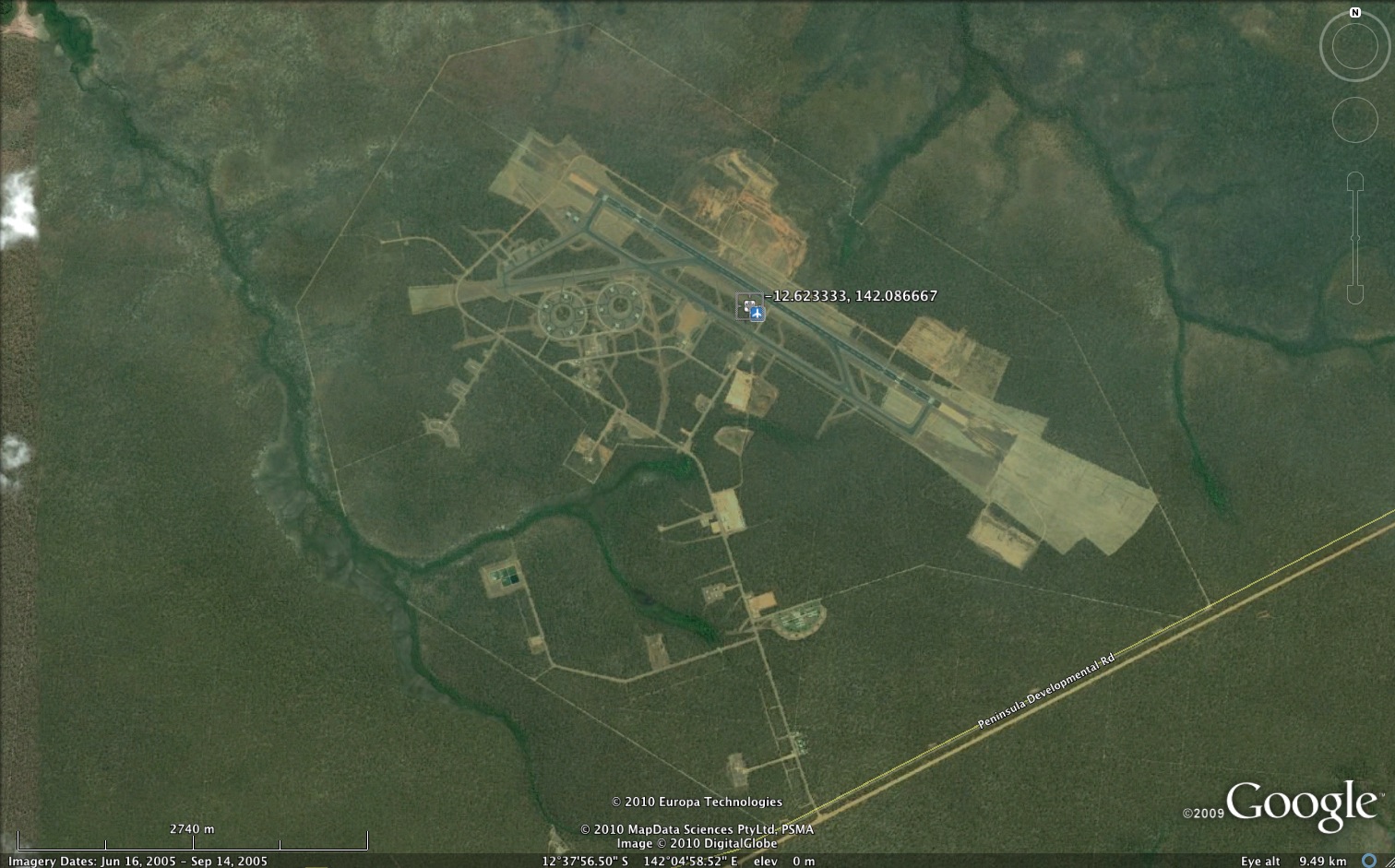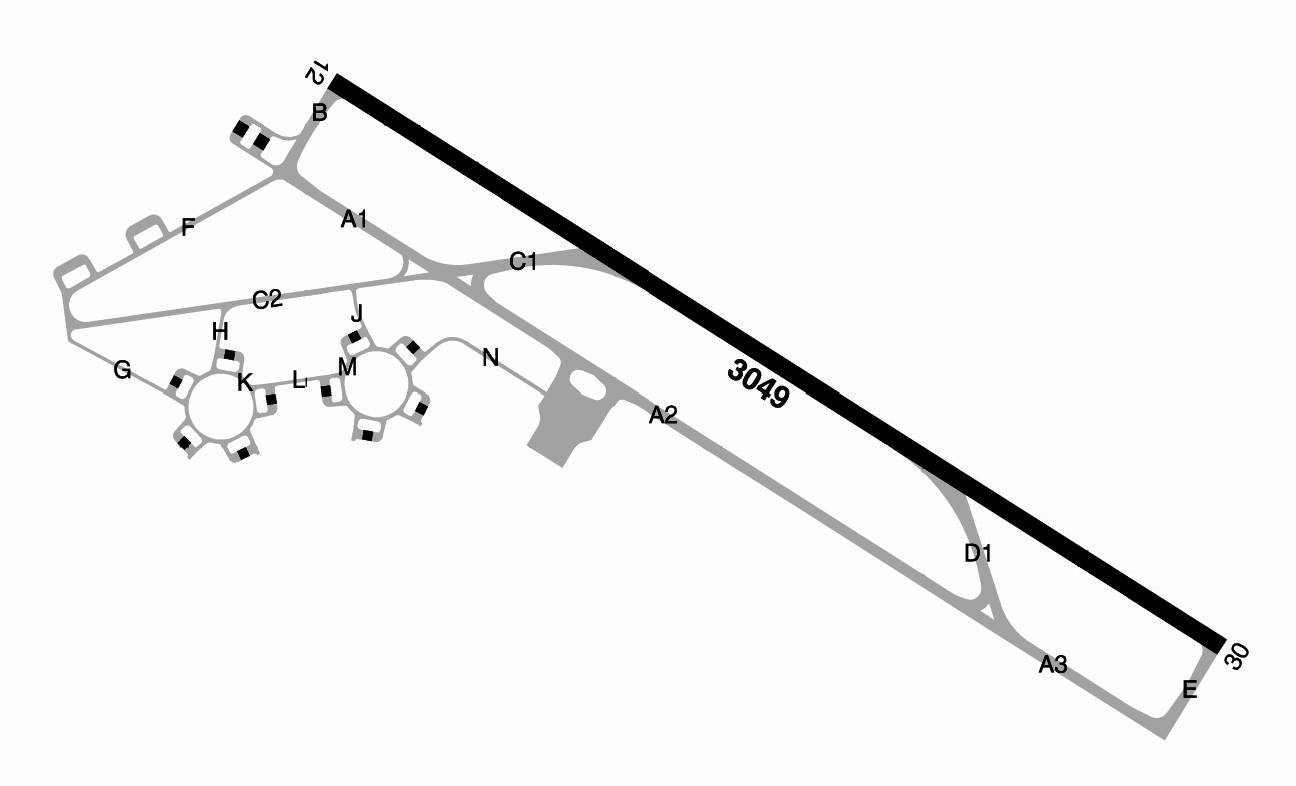RAAF Base Scherger
Introduction
RAAF Base Scherger is a 13,000 ha. Australian air force bare base or forward operating base 26 k. east of Weipa in north Queensland. It has a 3,000 metre runway, and minimal permanent facilities capable of expansion for exercises and operations. During recent exercises it has been used by F-111 aircraft, and is a planned forward operating base for F-35 joint strike fighters.
RAAF Scherger is also part of the Jindalee over the horizon radar system or Jindalee Operational Radar Network (JORN). Scherger is one of 12 locations in the JORN ionosonde network made up of vertical ionosodes that map the ionosphere. Like the wider JORN the Scherger ionosonde is operated by RLM, a joint venture of Lockheed Martin and Tenix.
In September 2010 the Immigration Minister announced, contrary to previous government denials, that the base would be converted to use as an immigration detention centre, initially housing 300 male detainees. Construction of the new facility was underway at least by July 2010. The gloval service company SERCO is to provide security at the detention centre. Serco Sodexco Defence Services provide environmental and other services to the base.
For information on the detention centre at RAAF Base Scherger see Scherger Immigration Detention Centre.
.
RAAF Base Scherger – Google Earth – image September 14, 2005 (larger image here) Google Earth placemarker (.kmz)

Source: An aerial view of RAAF Base Scherger, near Weipa, on 15 June 2007, Image Gallery, Department of Defence, 17 September 2010
RAAF Base Scherger

Government sources
RAAF Base Scherger (RAAF SCH) is located on Cape York approximately 26 km east of the township of Weipa. It is referred to as a ‘bare base’, used as a redeployment airfield for refuelling aircraft during ADF missions. No aircraft are permanently stationed at RAAF SCH. It is generally used for one or more exercises of several weeks duration each year (Unknown, 1998). The base facilities are contained within an inner area of about 5,650 ha known as the airfield core area which is surrounded by an airfield buffer area. The total airfield land is about 13,000 ha and extends from Mission River in the north to Marmoss Creek in the south. Facilities include runway and taxiways, aircraft aprons for parking and flight line servicing of aircraft. Minimal facilities for operations support, basic maintenance and site support are provided.
RAAF SCH operates as a Bare Base within the Cook Shire in Northern Queensland. The Base is approximately 23km west of the town of Weipa and the Napranum Aboriginal Community. The Base has a total area of approximately 13sq km and is generally bound by Mission River to the north, Marmoss Creek in the south (GHD, 2008) and undeveloped land to the east and west. Mining land uses occupy large areas of land to the west of RAAF SCH (approximately 12km away). Previously mined areas located between the Base and the current mining have been revegetated and now form undeveloped areas of land. Weipa is located to the west of the Base and incorporates residential development, commercial and community uses. Napranum, to the south of Weipa, also contains residential areas and commercial uses. The town of Weipa and is primarily driven by mining activities. RAAF SCH is Commonwealth land held by Defence. Part of the RAAF Base land is leased from the Peppan Land Trust, consisting of five Aboriginal landowners, and the Napranum Community Council (GHD, 2005). Land tenure adjacent the Base includes Camalco Mining Lease.
The surrounding area of RAAF SCH is unlikely to be developed for new land uses. Any future residential development is likely to occur in Weipa. Further development of mining areas is anticipated to the west of the Base; however these uses are unlikely to be sensitive to noise associated with the JSF aircraft.
Six spring sites of significance to Aboriginal people with interest in the land, the Peppan people, and one artefact site have been identified on RAAF SCH. In addition part of the land for the airfield is leased from the Peppan Land Trust which consists of five Aboriginal land owners and the Napranum Community Council. No archaeological material has been found in the open woodland part of the airfield core area (GHD, 2008). The Aboriginal land owners have requested that the spring sites and artefact site not be disturbed by the operations of the base. In addition it is a condition of the lease agreement that the Aboriginal land owners have rights of access to the springs.and land within the northern and southern buffer areas (GHD, 2008). The six springs and archaeological sites have been fenced and signed (except Spring No.2 which has been posted only) (Unknown, 1998).
As RAAF SCH is a ‘bare base’ the generation of waste is considered to be minimal. When in operation (during training exercises) waste quantities increase, with sewage and domestic waste being the main waste generated. On-site waste disposal and a sewage treatment facility have been established. Both facilities are lined with impermeable material to prevent contamination of the groundwater. The sewage treatment facility is a lagoon system with discharge of treated effluent occurring intermittently (i.e. towards the end of the wet season) (Unknown, 1998).
When an exercise is due to occur at the base, appropriate local waste contractors and waste management procedures are organised for the duration of the exercise.
RAAF Base Scherger, Report of Visit to Defence Establishments in Northern Australia, 26-29 July 1999, Joint Standing Committee on Foreign Affairs, Defence and Trade, Parliament of Australia, September 1999
2.2 In addition to the manned operational bases of Air Command, there are three bare bases at Learmonth, Curtin and Scherger in northern Australia. These bases have the infrastructure necessary to support operations and for use as a forward base for deployed forces. Of these bare bases RAAF Scherger was the last to be completed and was opened in 1998.
2.3 RAAF Scherger hosts one base activation per year and, on average, one aircraft transit per month. During base activations significant forces may be deployed to the Base but RAAF Scherger is permanently staffed by only a small caretaker staff comprising one Sergeant and two corporals. Caretaker duties include maintenance, security, airfield sweeping, nontechnical duty crew functions and assistance with local support of forces deployed to the base. Caretaker staff are also responsible for the supervision of contract maintenance tasks including rubbish collection, laundry, domestic cleaning and gardening.
2.4 RAAF Scherger provides significant operational facilities for deployed forces including a configuration of main, secondary and emergency runways that allow for simultaneous operations. The command, operational and maintenance facilities provided at the base are excellent but the Sub-Committee noted that all facilities were ‘fitted for but not with’ the equipment integral to a deployed force. The concept for the operation of the base calls for any deployed force to bring its own equipment and to provide its own operational services including air traffic control. The only exception to this concept appeared to be some larger scale Ground Support Equipment.
2.5 With regard to logistics, RAAF Scherger has a significant holding of aviation fuel and can, for a limited time, support daily requirements thatexceed 100,000 litres. The Base has the facilities to cater for 400 personnel in fixed accommodation and an additional 1000 personnel in tent lines. Kitchen and ablution facilities to support such a force are also provided. The Sub-Committee noted that the Base provides its own power and water but has no permanent hospital facilities.
Air Force Bare Bases, RAAF
The Royal Australian Air Force currently maintains three ‘bare bases’ in remote areas of northern Australia:
* RAAF Base Scherger, Weipa, Queensland
* RAAF Base Learmonth, Exmouth, Western Australia
* RAAF Base Curtin, Derby, Western Australia.
These bases were developed from as early as the 1950s to protect Australia by providing support for maritime, air and land operations aimed at securing our northern approaches. As front-line bases, bare bases consist of essential airfield support infrastructure – such as runways, taxiways, parking areas and maintenance facilities – which are used when the base becomes operational. Some equipment and supplies are stored at the bare bases for use when the base is activated, however, the bases house only a few caretaker personnel on a regular basis. A bare base is usually activated as part of a major Australian Defence Force exercise such as Exercises Pitch Black or Kakadu. Activating a bare base means that the base is brought to a fully operational state. To do this, Combat Support Group supplies the support required to set up the base and sustain the flying operations of the aircraft participating in the exercise. The activation of a bare base practices vital deployment procedures and sustainment of support requirements for the flying operations.
Scherger Awakes, Private John Wellfare, Air Force, 4714
Headquarters No. 395 Expeditionary Combat Support Wing has merged its major bare base activation exercise with Exercise Kakadu to get RAAF Base Scherger online to support F-111 operations. Exercise Northern Awakening, held every two years, practises combat support squadrons in moving into a bare base and preparing it for flying operations. This year’s exercise was the first time RAAF Base Scherger had supported fast jets. Plans officer at Headquarters No. 395 Expeditionary Combat Support Wing, Squadron Leader Kath Stein, said Exercise Kakadu had been an ideal opportunity for the headquarters to practise bare base activation. “[RAAF Base] Scherger is the mounting base for the F-111s, so they fly all their missions in support of Exercise Kakadu out of [the base].” She said there had been some significant advantages with basing the strike aircraft at RAAF Base Scherger, not least because the region had no curfews on fast jet flying hours. “RAAF Bases Darwin and Tindal both have noise restriction issues, whereas Weipa doesn’t have those issues and so far they’ve been very supportive. “In our planning phase we sought and received a lot of support, both from the [local] mining industry and the traditional owners of the land.” No. 381 Expeditionary Combat Support Squadron deployed to RAAF Base Scherger on July 19 to activate the base with the help of a range of other units, including No. 2 Air Field Defence Squadron, which provided security during the base activation phase and later flying operations.
Analysis
RAAF Base Scherger, Wikipedia [accessed 21 September 2010]
Our environment, Carpentaria Contracting
Carpentaria Contracting’s environment department was originally established to service the grounds at RAAF Base Scherger, a two yearly contract which we quote and have serviced the past 10 years. Carpentaria Contracting is currently engaged with Serco Sodexo in the maintenance of RAAF Base Scherger until 2019.
Serco Sodexco Defence Services
Serco Sodexco Defence Services (SSDS) is a dedicated prime contractor to the Australian Defence Organisation. We pride ourselves on service excellence to all our Defence clients through commitment to our Vision, Mission and Values. SSDS is a joint venture company formed in 1993 between two global service support companies: Serco Group – an international service company that provides effective management of people, processes, technology and assets and Sodexo – a world class integrated facilities management and multi service organisation. SSDS now has over 15 years experience providing facilities management support services to Defence. We have also placed consistently in the top 12 Defence contractors for the last eight years. As well as employing over 2800 Australians, SSDS engages hundreds of small business to assist with the provision of supplies and services. The Services menu on this website outlines a comprehensive list of these specialised services.
RAAF Scherger JORN iosonde
See also
Project coordinator: Richard Tanter
Updated: 22 September 2010



